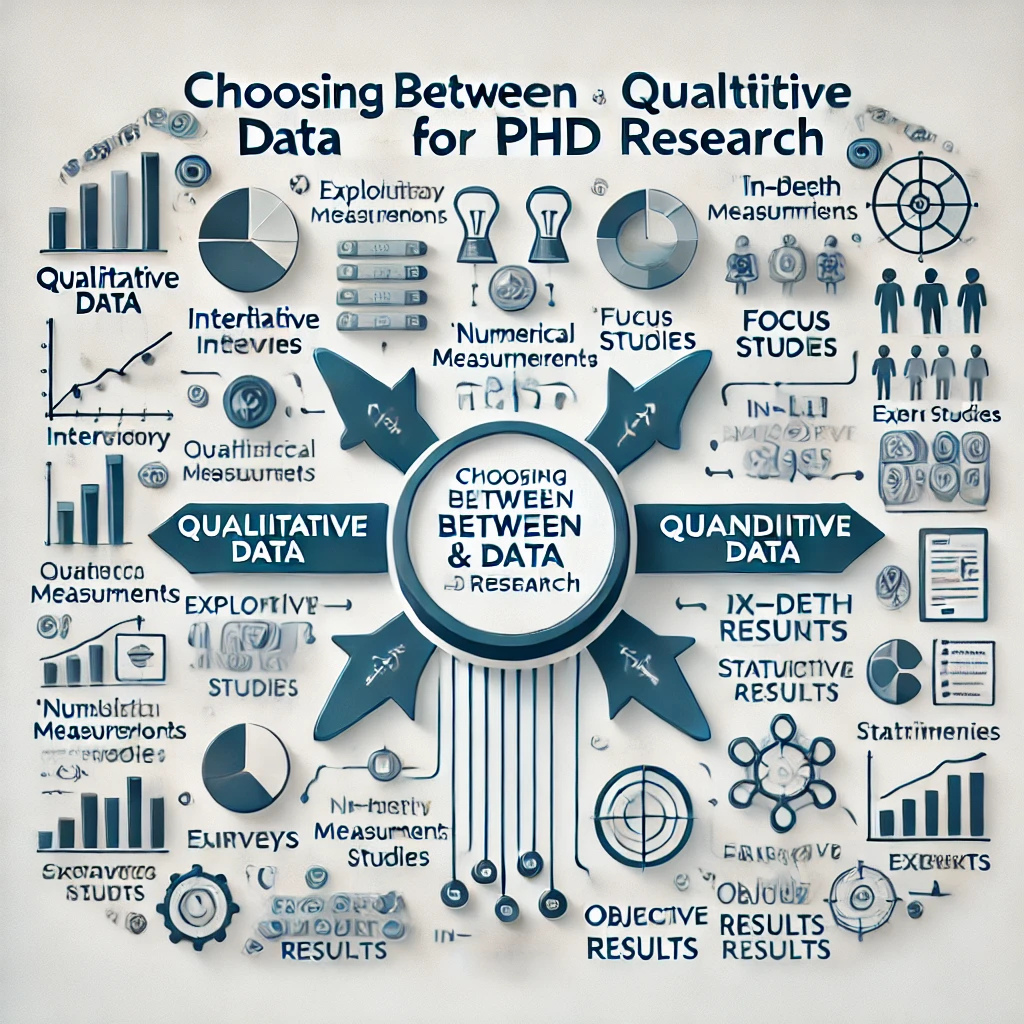Embarking on a PhD journey entails making numerous critical decisions, one of the most significant being the choice between qualitative and quantitative data. This decision is pivotal because it shapes the direction, methodology, and outcomes of your research. Both approaches offer unique advantages and cater to different research needs, making it essential to understand their key differences, benefits, and how each can be effectively applied to your research.
Qualitative data is centered around exploring the intricacies of human experiences, behaviors, and social phenomena. It provides a detailed, nuanced understanding of complex issues through descriptive and often open-ended methods. This approach is ideal for research questions focused on understanding the “why” and “how” behind various phenomena. Interviews are a primary method in qualitative research, involving detailed one-on-one or group discussions where participants can express their thoughts, feelings, and experiences in their own words. Depending on your needs, interviews can be structured with predetermined questions, semi-structured allowing for some flexibility, or unstructured, providing a more open-ended format. This flexibility allows for an in-depth exploration of participants' perspectives, making interviews suitable for capturing rich, detailed data.
Focus groups are another common qualitative method, where a facilitator guides a group of participants through discussions on a specific topic. This method is particularly useful for exploring collective opinions, attitudes, and experiences. By engaging with multiple participants simultaneously, focus groups can reveal a range of perspectives on a single issue, providing insights into group dynamics and consensus. Case studies involve an in-depth examination of a particular instance, event, or individual within its real-life context. This approach is valuable for gaining a comprehensive understanding of complex phenomena. Case studies are often used in fields like psychology, education, and business to explore specific cases in detail, offering rich, contextual insights that might not be generalizable but are deeply informative. Ethnography is an immersive qualitative research method where the researcher becomes part of the community or culture being studied. This approach provides a thorough understanding of social practices, behaviors, and cultural norms from an insider’s perspective. Ethnography is particularly effective for studying cultures or groups in their natural settings, allowing researchers to observe and interpret social interactions and norms from a first-hand viewpoint.

The benefits of qualitative data for PhD scholars are substantial. One of the main advantages is the depth of understanding it provides. Qualitative research uncovers rich, detailed insights into complex issues, revealing nuances that quantitative data might miss. This depth allows researchers to develop a comprehensive view of the subject matter, making qualitative research particularly valuable for exploratory studies. Qualitative research also offers flexibility. The methods are adaptable, allowing researchers to refine their focus and explore new avenues based on emerging findings. This flexibility is especially useful in dynamic or evolving fields where new information and perspectives continuously emerge. It enables researchers to adjust their approach as needed, providing a more responsive and iterative research process. Furthermore, qualitative data is human-centric, making it ideal for research centered on understanding personal experiences, cultural phenomena, or social processes. This approach provides valuable insights into the lived experiences of individuals and groups, offering a deeper appreciation of the complexities and subtleties of human behavior and social interactions.
In contrast, quantitative data focuses on numerical measurements and statistical analysis. It is best suited for research that requires measurable outcomes and objective analysis. Quantitative data allows researchers to test hypotheses, measure variables, and identify patterns through numerical data, providing clear, precise results. Surveys are a common quantitative method, involving structured questionnaires designed to collect data from a large sample. Surveys can generate extensive data sets that allow researchers to analyze trends, relationships, and correlations between variables. This method is particularly effective for gathering data on a wide range of topics from a large population, providing a broad overview of the research subject. Experiments are another key method in quantitative research. In experiments, researchers manipulate variables to observe cause-and-effect relationships. This controlled approach allows for the testing of hypotheses and the measurement of specific outcomes, providing robust evidence on how changes in one variable might influence another. Statistical analysis techniques, such as regression, correlation, and ANOVA, are used to analyze numerical data and identify trends and relationships between variables. These methods offer precise and objective insights, enabling researchers to draw data-driven conclusions and make predictions based on statistical evidence.
The benefits of quantitative data are significant. One of the main advantages is objectivity. Quantitative research provides measurable, verifiable data that reduces researcher bias and ensures that findings are based on empirical evidence. This objectivity is crucial for producing reliable and replicable results. Quantitative data also allows for generalizability. By using large sample sizes and statistical analysis, researchers can apply their findings to broader populations. This capability is particularly valuable for studies aiming to make generalizable claims or identify widespread patterns and trends. Additionally, quantitative data offers precision. The numerical nature of this approach allows for clear, concise results that can be easily interpreted and compared across studies. This precision is useful for answering specific research questions and testing hypotheses with a high degree of accuracy.
Choosing between qualitative and quantitative data involves several considerations. Start by defining your research question. Qualitative data is best suited for exploring “how” and “why” questions, providing in-depth understanding of complex issues. Quantitative data is more appropriate for answering “what,” “how much,” or “how many” questions that require measurable outcomes.

Consider your research goals as well. Qualitative methods are ideal for developing theories, gaining detailed insights, and exploring phenomena in depth. Quantitative methods are suited for testing hypotheses, measuring variables, and identifying relationships between factors. Evaluate your resources, including time, expertise, and data access. Qualitative research often requires significant time for data collection and analysis, with smaller sample sizes. Quantitative research may demand access to large datasets, statistical software, and expertise in data analysis. Ensure that you have the necessary resources to effectively carry out your chosen methodology. Think about your audience and how they will engage with your research. Qualitative data is engaging for those interested in narratives, personal experiences, and detailed case studies. Quantitative data appeals to those who prefer data-driven conclusions and statistical evidence. Tailor your methodology to align with the preferences and expectations of your target audience.
For some PhD projects, a mixed-methods approach that combines qualitative and quantitative methods can be highly effective. This approach leverages the strengths of both methodologies, providing a more comprehensive understanding of the research topic. By integrating qualitative insights with quantitative analysis, researchers can achieve a richer, more nuanced view of their subject.
In summary, choosing between qualitative and quantitative data is a critical decision that can significantly impact your PhD research. We at PhD Research Assistance offer unique advantages, by choosing the suitable one for your research question, goals, resources, and audience. By understanding the strengths and limitations of each methodology, you can make an informed decision that enhances the quality and impact of your research. Whether you opt for qualitative, quantitative, or a mixed-methods approach, your choice will shape the direction of your study and contribute to the advancement of knowledge in your field.